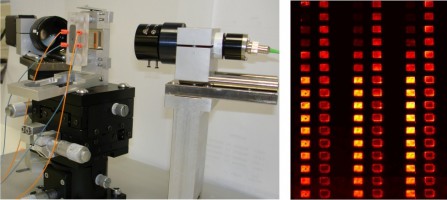Surface plasmon resonance sensors for parallelized observation of molecular interactions
Year: 2007
Assoc. Prof. Jiří Homola, Ph.D., DSc.
Surface plasmon resonance (SPR) biosensors represent one of the most advanced optical sensing technologies. SPR biosensors have become a central tool for label-free study of molecular interactions, and a mainstay of both life science and pharmaceutical research. SPR biosensors also hold potential for a wide range of bioanalytical tasks in sectors such as medical diagnostics, environmental monitoring, food safety and security [1]. Current SPR sensors lack high throughput and therefore development of SPR biosensors allowing simultaneous monitoring of hundreds or thousands of biomolecular interactions presents an important direction in the SPR sensor research.
We have developed two novel types of high-throughput SPR sensors. The first approach is based on spectroscopy of surface plasmons on an array of special diffraction gratings which form the sensor chip and uses a scanning mechanism to read more than 200 sensing channels within several tens of seconds [2, 3]. The other system combines imaging of the SPR-active surface with special spatially patterned multilayers in the polarization contrast to enable observation of molecular interactions in hundreds of sensing channels with high sensitivity and resolution [4, 5]. The developed high-throughput SPR sensors have been functionalized with appropriate surface chemistries [6] and used for characterization of antibodies [3] and detection of oligonucleotides [5].
- Homola, J.: Surface plasmon resonance sensors for detection of chemical and biological species, Chemical Reviews, in print.
- Dostálek, J. Homola, J., Miler, M.: Rich information format surface plasmon resonance biosensor based on array of diffraction gratings, Sensors and Actuators B, 107, 154-161(2005).
- Dostálek, J., Homola, J.: Surface plasmon resonance sensor based on an array of diffraction gratings for highly-parallelized observation of biomolecular interactions. – Sensors and Actuators B, in print.
- Piliarik, M., Vaisocherová, H., Homola, J.: A new surface plasmon resonance sensor for high-throughput screening applications. – Biosensors and Bioelectronics 20, 2104-2110 (2005).
- Piliarik, M., Vaisocherová, H., Homola, J.: Towards parallelized surface plasmon resonance sensor platform for sensitive detection of oligonucleotides, Sensors and Actuators B, 121, 1: 187-193 (2007).
- Vaisocherová, H., Zítová, A., Lachmanová, M., Štěpánek, J., Králíková, S., Liboska, R., Rejman, D., Rosenberg, I., Homola., J.: Investigating oligonucleotide interactions at subnanomolar level by surface plasmon resonance biosensor. – Biopolymers 82, 4: 394–398 (2006).


